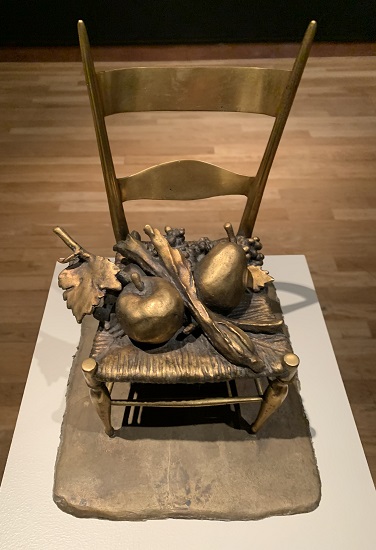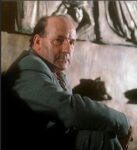
Giacomo Manzù
Italian, 1908-1991
Chair and Fruit, 1947
gilded bronze
11 1/4 x 9 1/2 x 9 1/2 in.
SBMA, Bequest of Wright S. Ludington
1993.1.22

Giacomo Manzù - undated photo
“The concept of a sculpture must not emanate from your bourgeois prejudices but only and exclusively from love. It is not only to you I say this: I constantly impress it upon myself as well.” - Giacomo Manzù
COMMENTS
For seven decades of the twentieth century, during which civilized nations have seen life-altering inventions and technological advances as well as the untold destruction of numerous wars, Giacomo Manzù has been about the work of creating a body of sculpture that has significantly altered mankind's visual and aesthetic perception. Not confined to a specific idiom, Manzù has been witness to the radicalization of natural forms in French and Spanish Cubism and the politicization of narrative storytelling in Futurism and Surrealism; in addition, he has observed in his lifetime the dichotomy that exists between the classicism of Maillol and the emotional departures that began with Rodin and culminated in German Expressionism. In such tempestuous times, numerous trends and vagaries of thought and action have created for all of mankind a very tenuous existence, which a worldly humanist like Manzù clearly articulates in his work, both sacred and profane.
Now in his eightieth year and a masterful proponent of an artistic career, he — like his much admired predecessors — has gained entrée into circles that include the world's most powerful churchmen, politicians, and intellectuals. The child of a poor family in Bergamo, as a youth he was apprenticed to a woodcarver. After undertaking eighteen months of compulsory military training, he began his vocation and career as a draughtsman and sculptor. During his early period, from the late 1920s to the outbreak of the Second World War, Manzù developed the major themes that would occupy him for a lifetime, producing copper and bronze relief sculptures based on religious narratives and fully round sculptures and portrait studies that are noted for their realism, quiet emotionalism, and genre qualities. Drawing, too, occupied some of his time, and early renderings, like his most recent works on paper, captured the essence of the subjects, making them easily translatable to stone and bronze. In the early sculptural works, he often used specific props such as a simple chair or a platform-like stage, which he would continue to employ, albeit with some modifications, throughout his career. …
From 1945 to 1955, Manzù became known for his formal conceptions and major commission projects. He exhibited more frequently on an international scale, receiving for his efforts many awards and prizes, including the all-important prize for Italian sculpture at the XXIV Biennale. During 1949, two themes that began to emerge in the late thirties seemed to reach a sense of completion. The much-celebrated bronze and stone cardinals with their conical-shaped vestments are presented as self-contained, sealed environments, symbolizing the mysteries of the Church, its rituals and its dogma. Manzù’s continued use of the churchman imagery, in relief and fully round sculpture, speaks of his preoccupation with sacred and spiritual ideas, while his genre or profane imagery — including dancers, ice skaters, active children, and remarkable studies of young women — show him to be equally as passionate a sightseer and sensitive purveyor of the world around him. This exciting thematic dichotomy of the sacred and profane has contributed in great measure to worldwide appreciation of Manzù’s virtuosity and wide-ranging intellect, which allows him clear passage between diametrically opposed ways of seeing. …
Continuing into the 1970s and 1980s, Manzù has been dramatically recycling his own aesthetic past, revising and refining ideas introduced four and five decades earlier and infusing them with a vitality that makes each seem a new creation. This is especially noticeable in the venerable series of chair still-lifes, which the artist began to produce in the early 1960s, initiating exciting transformations in the progress of time. The simplest object, a wooden chair, which earlier served as a support for other objects, eventually becomes a subject itself, decorated and adorned with bouquets, harvest-time produce, leafy branches, and often a piece of cloth used as a drape or wrapping for the many components in the composition. Examining these productions, one thinks immediately of majestic seventeenth-century Dutch still-life paintings and their visible language of hidden meanings. But unlike the rigorous symbolism that was required in the seventeenth century, Manzù’s imagery is more casual, earthly, with an iconography that reveals and celebrates the realities of everyday life.
Some years ago, John Rewald wrote: “with calm certainty, based on things already achieved, [Manzù] dedicates himself to the only task he knows, namely to give form and thus permanence to his perceptions and slowly nurtured intentions." Today, Giacomo Manzù, a cobbler’s son, can look back on seven decades of inquiry into the nature of mankind. With his deeply plumbed emotional sensibility he has eloquently described the spiritual side of man, and his circumspect sensitivity toward genre subjects has earned him renown as a visual and aesthetic raconteur who is able to occupy multiple spaces in a world he sees as both sacred and profane. His remarkable achievements cannot fail to leave a lasting impression on any spectator.
- Steven White Rosen, Giacomo Manzù, London: Wildenstein, 1989, pp. 5-11
SBMA CURATORIAL LABELS
Manzù is an artist who falls between stylistic categories, although he is known to have been profoundly influenced by Rodin, Maillot, and especially his Italian forerunner, Medardo Rosso. Rosso is now considered a Symbolist, as is Rodin in his late work. In this bronze, a meticulously rendered still life of an apple, pear, grapes and game bird, presented on a rustic chair - itself rendered with an equal amount of illusionistic detail - have a Surrealist whimsy in their absurdist disproportion. Whiffs of a child’s playhouse version of scale authorize the artist’s unfettered play of imagination.
- The Iconography of Dread: Symbolism to Surrealism, 2023
